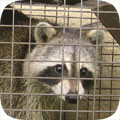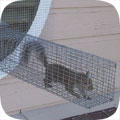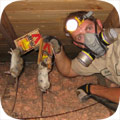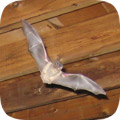- stpeters@wildlifeanimalcontrol.com
Call 24/7 for a free quote:
636-524-4456
St Peters Wildlife Animal Control
Professional Wildlife Removal Company Servicing St Peters, MO
If you have a problem with wildlife in your St Peters home, your best option is to hire a company that specializes in Missouri wildlife removal only. This is a specialty business, and regular pest control companies do not use the proper techniques to solve animal problems. I have spent many years reviewing Missouri and St Peters, and I recommend the following:
Boone Wildlife Control
Cell Phone: 636-524-4456
NOTE: If you have a dog or cat problem, call St. Charles County Animal Services: 636-278-2255

Boone Wildlife Control specializes primarily in removing animals from attics of homes and buildings - this includes squirrels in attics, raccoons, and rats or mice in homes. Missouri also has a documented problem with
bats in buildings, and Boone Wildlife Control is specially trained in bat removal. They also perform general wildlife trapping services, such as the capture and removal of skunks or opossums on the
property. Call 636-524-4456 to discuss your critter problem and schedule a same-day or next-day appointment. Click here to learn more about
what prices we charge in 2024.
When hiring a company to solve your wild animal problem, you want these features:
- Specializes in wildlife removal, not pest control
- Fully Missouri and St. Charles County licensed and insured
- Works 7 days per week (critters don't take weekends off)
- Performs full building inspections: enters and inspects attic
- Performs exclusion repairs, with guarantee against animal re-entry
- Offers cleanup of biohazardous wildlife waste
Boone Wildlife Control is a full-service St Peters wildlife removal company. This is very different from a regular St Peters pest control company. The pest control companies spray poison to kill insects. This is not at all
similar to wildlife removal. Boone Wildlife Control performs a full inspection of the home or property, and determines why the animal(s) are there, and if inside a building, how the animals got inside. All
animals (including rodents) are trapped and removed, or if possible, removed from the building using special exclusion devices. Once the animals are gone, preventative repairs are essential, and
cleanup is sometimes recommended.
 St Peters wildlife trapping - it's not as simple as it may seem. It's illegal in Missouri to trap without a license. Trap type is very important and there are many different types, bait is somewhat relevant, trap placement
is vital, and there are dozens of small things that are very important to know.
Safety is a concern. Then once the animal is trapped, it must be removed and dealt with in the proper manner according to Missouri law. We offer St Peters raccoon removal. Read more about how to get rid of raccoons.
St Peters wildlife trapping - it's not as simple as it may seem. It's illegal in Missouri to trap without a license. Trap type is very important and there are many different types, bait is somewhat relevant, trap placement
is vital, and there are dozens of small things that are very important to know.
Safety is a concern. Then once the animal is trapped, it must be removed and dealt with in the proper manner according to Missouri law. We offer St Peters raccoon removal. Read more about how to get rid of raccoons.
 Animals in attics - this is our specialty at Boone Wildlife Control. Many types of animals like to live in attics. This includes squirrels, raccoons, rats, mice, bats, birds, and even possums. Critters like to go into attics for a safe place to live
and raise their young. Removing animals from attics is very complex work, partly because of the presence of baby animals. If you need St Peters squirrel removal, we can remove all the squirrels from your attic, and seal out any future ones. Read more about how to get rid of squirrels.
Animals in attics - this is our specialty at Boone Wildlife Control. Many types of animals like to live in attics. This includes squirrels, raccoons, rats, mice, bats, birds, and even possums. Critters like to go into attics for a safe place to live
and raise their young. Removing animals from attics is very complex work, partly because of the presence of baby animals. If you need St Peters squirrel removal, we can remove all the squirrels from your attic, and seal out any future ones. Read more about how to get rid of squirrels.
 Rodent control must be done in a very specific way. First off, the most important thing is that all the openings that rats and mice can use to enter a house be sealed. Then all the rodents must be physically trapped and removed.
Never, ever use poison! Most St Peters exterminators will just use this lazy poison technique to kill rodents, and it causes more harm than good - dead stinky rats, and it doesn't solve the problem. Call us for correct St Peters rat removal. Read more about how to get rid of rats.
Rodent control must be done in a very specific way. First off, the most important thing is that all the openings that rats and mice can use to enter a house be sealed. Then all the rodents must be physically trapped and removed.
Never, ever use poison! Most St Peters exterminators will just use this lazy poison technique to kill rodents, and it causes more harm than good - dead stinky rats, and it doesn't solve the problem. Call us for correct St Peters rat removal. Read more about how to get rid of rats.
 Bat removal is a highly specialized task. Missouri is known to have colonizing bats who often live in buildings. Bats love attics. If not removed, the colony can grow to a very large size over the years. The bat droppings are often corrosive and
cause health risks. The same goes for bird droppings on or in buildings. We perform St Peters pigeon removal and bird control. But our specialty is St Peters bat removal. We remove 100% of the bat colony and seal the building so that it's totally bat-proof. Read more about how to get rid of bats.
Bat removal is a highly specialized task. Missouri is known to have colonizing bats who often live in buildings. Bats love attics. If not removed, the colony can grow to a very large size over the years. The bat droppings are often corrosive and
cause health risks. The same goes for bird droppings on or in buildings. We perform St Peters pigeon removal and bird control. But our specialty is St Peters bat removal. We remove 100% of the bat colony and seal the building so that it's totally bat-proof. Read more about how to get rid of bats.
 If you have animals inside a house, no job is complete without proper exclusion repairs. If you simply hire a St Peters trapper who only removes the critters, then the problem will return. You need to hire a St Peters wildlife control company that identifies 100% of the animal entry points
into your building, and seals them shut with professional repairs. In addition, in many cases animals have left waste or contamination behind, and you'll want a company that can provide professional cleaning services. Boone Wildlife Control does both.
If you have animals inside a house, no job is complete without proper exclusion repairs. If you simply hire a St Peters trapper who only removes the critters, then the problem will return. You need to hire a St Peters wildlife control company that identifies 100% of the animal entry points
into your building, and seals them shut with professional repairs. In addition, in many cases animals have left waste or contamination behind, and you'll want a company that can provide professional cleaning services. Boone Wildlife Control does both.
The above are just some of the services offered by Boone Wildlife Control. We also trap and remove animals that destroy lawns, such as moles, or digging animals. Sometimes animals like opossums will live under buildings, steal pet food, raid garbage cans, etc.
Read about how to get rid of opossums. Skunks commonly live under sheds or decks, and set up a den. We can trap and remove them without them spraying. Read about how to get rid of skunks. Boone Wildlife Control
also provides dead animal removal in St Peters. If you need help with any other wildlife conflict, from a fox, beaver, groundhog, or any other critter, we can solve it. We also do St Peters snake removal - most of the snakes in Missouri are not venomous, but
call us if you want safe removal, or read about how to get rid of snakes in St Peters. And remember, we are a private business, not St. Charles County Animal Control Services, so if you have a dog or cat problem, call the County at 636-278-2255.
St. Charles County animal services does not handle any wildlife issues.
Boone Wildlife Control
Cell Phone: 636-524-4456
St Peters Pricing Info
Every wildlife removal situation is different, from the species of animals involved, the location of the animal inside a house or outside, the extent of repairs or cleanup, etc. It's impossible to give one-size-fits-all prices. Examples MIGHT include:Small Job: For example, a one-stop job to remove an animal in the yard: $100 on up
Medium Job: For example, getting critters out of your house with minor repairs: $300 on up
Large Job: For example, a project involving many service trips and complex work: $500 on up
Give us a phone call now and tell us about your wildlife issue and we will be able to give you a price estimate over the phone. If you're cool with it, we can schedule a same-day or next-day appointment if you like. Our prices are fair, and a good value because we do the job right, the first time.
St Peters Wildlife Tip #1:
How to remove an animal living under a shed or porch
Wild animals like to live in dark and warm places and under a shed or a porch is one of those places. Most of us find ourselves torn between removing the animal from under there or letting it stay. I will not give a specific answer but remember, those animals can be sources of diseases to your pets or members of your household. Deciding to remove it is one thing, and then there is how to go about it. Let us find out how.
Signs that will help you know the animal living under the shed or porch and the methods to use
Realizing that there is an animal living under the shed is the first step of this process. Some of the signs that will help you include the presence of wild animal dropping around the shed or porch. The presence of scales in case of snakes. The presence of wild animal nests. Observing an animal living from under the shed or noises from under the shed or porch.
Removing the animal from under the shed or porch
There are so many methods that you can use to remove the animal from under there. However, be sure of the kind of animal living under there, if it has young ones and if the method that you have picked can kill or harm it. Some of the methods you could use are as follows. Do nothing at all. Most animals live under a shed or pod for a short period for either breeding purposes or escaping winter. Give it time, if it does not live pick any other method discussed below. Or, you may opt to interfere with the conditions that attracted the animal to your place. Such conditions include the light, noise, and smell. Light, find the entry hole of the animal and place a source of light there. The animal cannot ignore this position and it will have no option but to leave. Noise, most animals prefer quit areas, by placing a radio near where those animals live will send them away with ease. Smell, soak a cloth in apple cider vinegar or ammonia on the entry hole of the animals. Almost all animals despise this smell and hence they will evict from underneath there. Setting a one way trap's mission is to remove the animal by keeping it alive. Setting a trap that can only allow the animal out but cannot allow it to return is ideal.
Conclusion
There are many ways of evicting an animal. Always consider the animal you are dealing with before applying any of the method. Some animals are excessively dangerous.
St Peters Wildlife Tip #2:
Missouri Wildlife Information:
Missouri State bird: Eastern bluebird
State mammal: Missouri mule
State reptile: Three-toed box turtle
State amphibian: North American bullfrog
State fish: Channel catfish, paddlefish
State insect: European honeybee
Missouri is a state that is wetter than most people think. It was originally classified as a southern state, and eventually became grouped with the states in the Midwest. As far as Midwest states go, however, it is full of wet grasslands which gradually culminate through foothills into the Ozark Mountains. Though much of the landscape is flat, the region has a fair amount of forest. It is humid with hot summers and cold winters.
A state with such ample grasslands is bound to have a good number of large grazing animals, and Missouri definitely fits the bill. This state has white-tailed deer, elk, and American bison. The bison, which are growing in popularity for food consumption around the globe, are in both wild and semi-wild herds. Their numbers are significantly less than when they roamed the plains hundreds of years before pioneers came through.
No predators are large enough in Missouri to take down a full-sized bison, though sick adults and young calves will occasionally be prey for coyotes or mountain lions. It is rare to see a mountain lion out on the plains; in fact, it is rare to see one of the big cats at all. The species vanished from Missouri in the 1970's only to reappear in the mid 1990's. The game commission in the state does not feel there is a breeding population of the cats, and any cougar sightings are animals that have come in from other states.
Another creature that enjoys life out in the grasslands is the badger. These aggressive, intimidating animals are excellent diggers, and they live primarily off a diet of rodents found in prairie grass. The badger can be a fierce protector of its den, and people are advised to keep their distance from this critter.
There is, of course, no shortage of home invading species in Missouri. The state has an ample supply of raccoons, foxes, bats, skunks, porcupines, opossums, nutria, muskrats, and squirrels.
The wetlands in the region are home to a few animals that are slowly vanishing as the swamps dry up. The swamp rabbit is a critter found in the southern swamps of Missouri, and its numbers have been steadily declining as the wetlands get destroyed. Another species that is gradually going away is the alligator snapping turtle, a reptile that can grow to be 150 pounds.
You can always call Boone Wildlife Control, any time of day, at 636-524-4456, for a price quote for St Peters wildlife control services. I am confident that this is the best choice amongst wildlife removal companies in St Peters, MO.







































